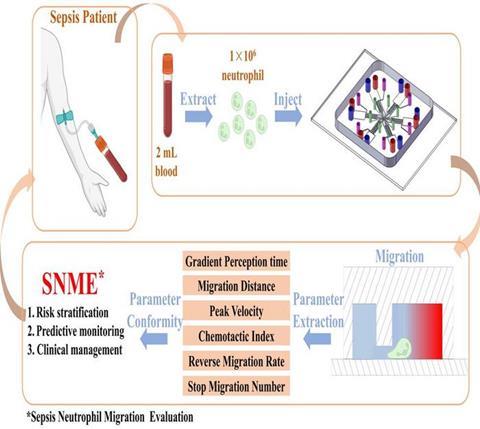A research team led by Associate Researcher Yang Ke from the Hefei Institutes of Physical Science of the Chinese Academy of Sciences, in collaboration with the First Affiliated Hospital of Anhui Medical University, developed a new prognostic evaluation method for sepsis patients using a microfluidic concentration gradient chip.
The research results were published in Talanta and SHOCK.

Sepsis, a severe and life-threatening condition, arises from an uncontrolled immune response that leads to multi-organ dysfunction.
READ MORE: A human-centered AI tool to improve sepsis management
READ MORE: Nasal microbiota is potential diagnostic biomarker for sepsis
Due to its high mortality and the limitations of current diagnostic and monitoring tools, there is an urgent need for more advanced methods to evaluate and manage sepsis effectively.
Microfluidic chip
In this study, researchers employed a microfluidic chip to investigate the chemotactic migration behaviors of neutrophils and T lymphocytes in sepsis patients. They discovered significant differences in the migration parameters of neutrophils between sepsis patients and healthy controls. These parameters included gradient sensing time, migration distance, peak velocity, and chemotactic index.
Based on these findings, the researchers developed a comprehensive evaluation index for neutrophil migration function that was strongly correlated with established sepsis severity markers, as well as commonly used biomarkers.

The team also focused on T cell migration in sepsis patients and discovered it was impaired due to changes in the plasma microenvironment. Elevated NADH/NAD+ levels in T cells were linked to mitochondrial dysfunction. By using the mitochondrial-targeted drug MitoQ, they were able to reverse these abnormalities and restore T cell migration function, offering a potential therapeutic approach for sepsis.
These results offer a promising new strategy for sepsis diagnosis, disease progression evaluation, and prognosis monitoring. The comprehensive index and the potential of mitochondrial-targeted therapies provide new theoretical insights, opening up new possibilities for improving sepsis management and patient outcomes.







No comments yet